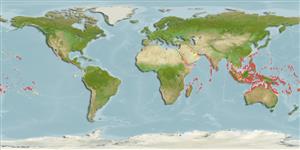Common names from other countries
>
Anguilliformes (Eels and morays) >
Muraenidae (Moray eels) > Muraeninae
Etymology: Gymnothorax: Greek, gymnos = naked + Greek, thorax, -akos = breast (Ref. 45335).
More on author: Bleeker.
Environment: milieu / climate zone / depth range / distribution range
Écologie
marin; saumâtre récifal; profondeur 0 - 25 m (Ref. 37816). Tropical; 30°N - 24°S
Indo-Pacific: Red Sea and East Africa (Ref. 33390) to the Tuamoto Islands, north to the Ryukyu and Hawaiian islands, south to Australia. Eastern Central Pacific: Costa Rica and Panama (Ref. 9324) and the Galapagos (Ref. 2334).
Taille / Poids / Âge
Maturity: Lm ? range ? - ? cm
Max length : 38.7 cm TL mâle / non sexé; (Ref. 90102)
Épines dorsales (Total): 0; Rayons mous dorsaux (Total): 0; Épines anales 0; Rayons mous anaux: 0; Vertèbres: 109 - 117. Dark brown with irregular dark spots anteriorly, interspersed with lighter granulations that form diffuse crossbars on the tail.
Occurs in shallow lagoon and seaward reefs, primarily found in the surge zone (Ref. 9710). Benthic (Ref. 58302). Lives between rocks and corals.
Life cycle and mating behavior
Maturité | Reproduction | Frai | Œufs | Fécondité | Larves
Chen, H.-M., K.-T. Shao and C.T. Chen, 1994. A review of the muraenid eels (Family Muraenidae) from Taiwan with descriptions of twelve new records. Zool. Stud. 33(1):44-64. (Ref. 6934)
Statut dans la liste rouge de l'IUCN (Ref. 130435)
CITES (Ref. 128078)
Not Evaluated
Menace pour l'homme
Harmless
Utilisations par l'homme
Pêcheries: sans intérêt
Plus d'informations
Noms communsSynonymesMétabolismePrédateursÉcotoxicologieReproductionMaturitéFraiFéconditéŒufsDéveloppement de l'œuf
RéférencesAquacultureProfil d'aquacultureSouchesGénétiqueElectrophoresesHéritabilitéPathologiesTraitementMass conversion
Outils
Articles particuliers
Télécharger en XML
Sources Internet
Estimates based on models
Preferred temperature (Ref.
115969): 25.5 - 29.3, mean 28.4 (based on 2903 cells).
Phylogenetic diversity index (Ref.
82804): PD
50 = 0.5000 [Uniqueness, from 0.5 = low to 2.0 = high].
Bayesian length-weight: a=0.00071 (0.00046 - 0.00110), b=3.32 (3.19 - 3.45), in cm Total Length, based on LWR estimates for this species & Genus-body shape (Ref.
93245).
Niveau trophique (Ref.
69278): 3.8 ±0.65 se; based on food items.
Résilience (Ref.
120179): Milieu, temps minimum de doublement de population : 1,4 à 4,4 années (Preliminary K or Fecundity.).
Fishing Vulnerability (Ref.
59153): Low to moderate vulnerability (29 of 100).
